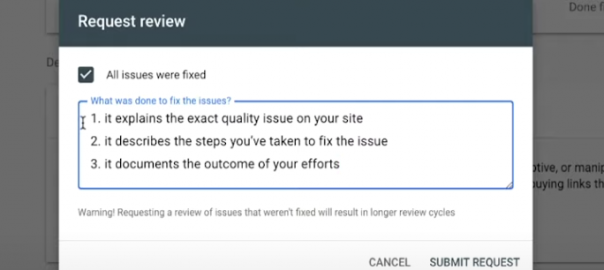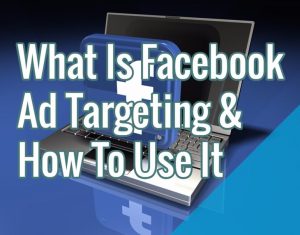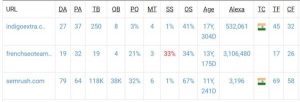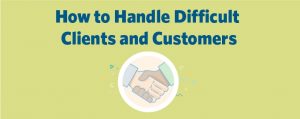We look at what a Google penalty means for your website, the difference types you can get, why you might get one in the first place and how to remove a Google penalty.
Receiving a Google penalty is a nightmare scenario for website owners. In most cases, they cause a significant drop in traffic and getting penalties lifted can take a long time, depending on the nature and severity of your violations.
The best way to handle Google penalties is to avoid them altogether but, sometimes, website owners get hit without meaning to violate any guidelines. So, whatever, the reason may be, let’s look at how you can avoid receiving them and how to remove a Google penalty if you’re ever on the receiving end.
What is a Google penalty?
Google penalties are strikes against individual websites that demote certain ranking factors in Google’s search algorithm. For example, if you receive a search penalty due to low-quality links, the value your website/pages receive from these links will be demoted and the ranking benefits diminish.
Google penalties are also known as “manual action penalties,” meaning they’re applied manually to your website or pages by a human reviewer. This allows Google to target dodgy SEO practices that might game its algorithm without human input.
Google hasn’t confirmed how this process works but it’s a fair assumption that suspicious sites/pages are automatically flagged up and, then, reviewers can decide whether the website or pages in question deserve a penalty.
If you receive a manual penalty, you’ll get a notification in Search Console (example below) and you should also get an email sent to the address assigned to your account. The notification will explain why you’ve received the penalty, how your website or pages are being affected and how you can remove the Google penalty.
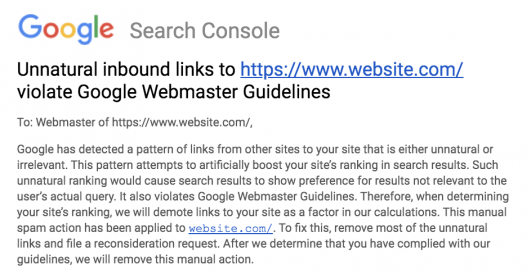
There are various types of Google penalties, which we’ll explore in the next section, but the key point is that penalties are manually applied. Manual action penalties are not automated and they’re not related to algorithm updates in any way.
Algorithm updates are universal changes to Google’s search algorithm and, while these can affect your search ranking (sometimes worse than a manual penalty, even), algorithm updates apply to everyone, not only your website.
How do I get Google penalties?
There are roughly a dozen manual action penalties related to Google Search but some are less relevant than they used to be and some no longer exist at all, such as First Click Free violations (First Click Free was phased out in 2017). Here’s a quick summary of the manual action penalties that matter for Google Search in 2021.
Pure Spam penalties
This is the manual action penalty you never want to receive and very difficult to recover from. While it’s possible to receive some manual penalties accidentally, with no bad intentions, you’re only going to receive a penalty for spam if you’ve been up to some dodgy stuff: auto-generating content, scraping content from other sites, deceptive cloaking and deliberately deceiving Google and users into accessing content they’re not interested in.
How to fix: If you get hit with a Pure Spam penalty, you need to revamp your entire website/content to show Google things have changed drastically before you can recover. Follow Google’s Webmaster Guidelines to the letter, compare your site against the top-ranking rivals for your primary keywords and aim for the same level of standards, nothing less.
Unnatural link penalties
By far the most common manual penalty handed out by Google is related to unnatural links and there are two key triggers for this:
- Unnatural inbound links: Links from third-party locations pointing to your website that show obvious signs of being spammy or harmful.
- Unnatural outbound links: Links on your website pointing to external domains considered spammy or harmful.
The most common trigger for unnatural link penalties is paying for links through sponsored or paid content. SEMrush data shows that more than half (53%) of unnatural link penalties are attributed to sponsored or paid links, while guest posts and press releases (45%), and PBNs and link networks (27%) are the other two top causes. The same study shows that “in most cases, it is the combination of 2-3 or more types of manipulative behaviour that triggers penalties”.
How to fix: Invest resources into earning high-quality links from relevant, authoritative websites through quality content and legitimate networking. Run regular link audits to identify and disavow problematic links and never engage in paid link building (inbound or out).
Thin & duplicate content penalties
Thin content and duplicate content penalties used to be very common, too, but they’re pretty easy to avoid. The first thing to understand is that some pages justify having thin content, such as contact or login pages, and Google isn’t going to penalise you for these. These days, only low-quality pages with little or no content are going to get flagged up by Google. However, this could include auto-generated, spun or scraped content and doorway pages simply designed to direct users elsewhere.
There are some situations where you could get hit by a thin or duplicate content penalty without intending to do anything wrong, though – such as product pages with very little content or duplicate descriptions.
How to fix: Aim for a minimum of 300+ words of unique content on any page that’s designed to inform users or encourage them to take action. Identify pages with low word counts and find ways to add value to them instead of padding them out with fluff.
Keyword stuffing & hidden text penalties
Keyword stuffing was a popular spam technique in the old days and Google’s algorithm was easier to game by forcing keywords into content. This isn’t the case anymore because Google is less reliant on keywords and more capable of analysing the quality of entire pages. Hidden text is fine, as long as it’s relevant content being hidden in a way that enhances the user experience – eg: product description tabs to help users navigate information.

As soon as you start hiding content that’s not relevant to the query your page ranks for, you’re venturing into deceptive territory and you could get penalised for this.
How to fix: Open up Search Console, head to the URL Inspection tool (previously Fetch as Google) to view affected pages. Look for hidden text using CSS, positioning or JavaScript and decide whether to remove the content altogether (deceptive) or re-style the content in a way that communicates function more effectively to users.
Cloaking & deceptive redirects
Cloaking is where you show different content to users from the content Google’s bots index and rank. This is normally done by redirecting users from the indexed URL to another page and there are plenty of instances where this is perfectly acceptable – eg: A/B testing page variations, language selection, log-in redirects, etc. This is why manual penalties exist: so human reviewers can look at redirects to determine whether they’re beneficial to the experience or deceptive.
Cloaking redirects were a classic black hat SEO tactic in the old days, redirecting users to irrelevant pages or under-optimised, low-ranking pages, for example, and these are the kind of deceptive tactics that might result in a manual penalty.
How to fix: Open up Search Console, head to the URL Inspection tool to compare the content Google fetches vs the content on your page. Check your redirects and remove anything that could be interpreted as deceptive or unnecessarily disruptive to the user experience.
Hacked site penalties
This is something every website owner needs to take seriously. Google doesn’t want to send users to hacked sites and if it picks up on signs that your site has been compromised, it adds a “This site may be hacked” label to your search listings as a warning to potential visitors. This often results in a demotion in the organic SERPs, too.

How to fix: Contact your hosting provider and ask for assistance. Restore a clean backup of your website, head to Search Console and head to the Security Issues section to see details about your compromised pages, follow the steps in Google’s resources for hacked sites and request a review once you’ve fixed the issues.
You can find the full list of manual action penalties, including the 12 new violations Google introduced for Google News and Discover on this Search Console Help page.
How do I stop Google penalties?
As with most things in SEO, it’s better to take preventative measures to avoid receiving manual action penalties in the first place. Recovering from penalties can be difficult but the bigger picture is that you’ve got serious problems with your website if Google’s manual reviewers feel the need to hand out a penalty these days.
A penalty isn’t telling you that your website could do with an upgrade; it says that you’re intentionally trying to deceive Google’s search engine and/or users.
A lack of SEO knowledge can easily lead to Google penalties and the most common occurrence of this is link penalties where website owners either don’t know how link building works, have been misinformed by others or simply can’t be bothered to put the work in. If you don’t have the SEO knowledge to build natural link profiles or optimise your pages, get someone on board who does.
The most important thing to understand about search engine optimisation is that it’s a long-term strategy and shortcuts do not work. You have to put the early groundwork in and build an online platform that offers genuine value to users (and, by extension, search engines).
Do this properly and you’ll start to see traction within the first 3-6 months and growth will continue without any worries about Google penalties. On the other hand, if you try to cut corners, it’s only going to take longer to build any kind of traction and you’re in danger of violating the guidelines that can trigger manual reviews.
Remove Google penalties
To remove a Google penalty from your website, you have to fix the issues flagged up and then show Google that everything is resolved before your penalty will be lifted. So, the typical process for removing a manual action penalty involves three key steps:
- Identify & fix all relevant issues
- Send a reconsideration request to Google
- Put preventative measures in place to avoid further penalties
Keep in mind that you may need to send multiple reconsideration requests to Google before your penalty is lifted. The time it takes to remove a penalty varies greatly, depending on the severity of your violations and your ability to identify and fix all of the offending issues.
At the very least, you’re looking at weeks or months to remove a Google penalty. In some cases, it can take longer and, in some rare cases, you may never be able to recover (eg: from multiple Pure Spam penalties).
Step #1: Identify & fix all relevant issues
When Google sends you notice of a manual action penalty, your notification should point you in the right direction of the guidelines you’ve violated. So, if you’ve received a penalty for unnatural inbound links, Google will send you a message along the lines of:
“Google has detected a pattern of links from other sites to your site that is either unnatural or irrelevant. This pattern attempts to artificially boost your site’s ranking in search results. Such unnatural ranking would cause search results to show preference for results not relevant to the user’s actual query… To fix this, remove most of the unnatural links and file a reconsideration request. After we determine that you have complied with our guidelines, we will remove this manual action.”
This message specifies that a significant number of links pointing to your website aren’t relevant to your content or the user search queries your content is ranking for. It also says that you need to remove most of the unnatural links to get the penalty removed and send a reconsideration request.
So, the first step is to identify all of the unnatural links pointing towards your website and the determining factor here is relevance. You can do this in Search Console by taking the following steps:
- Open the Manual action report in Search Console.
- Expand the manual action description and clarify that you understand the issues you need to fix.
- Click the “Learn more” link for detailed information on the violations you’ve been penalised for.
- Identify the issue on every relevant page – fixing the issue on some pages for a site-wide penalty will not earn a partial recovery.
- Fix every issue you can identify.
- Ensure that Google can access all affected pages to review your site.

Just like Google has manually evaluated the relevance of links pointing towards your website, you need to sit down and manually evaluate the relevance of every inbound link and decide whether each one adds value to the user experience.
Here are some examples of links you should remove:
- Links you’ve paid for
- Links from high-quality websites that aren’t relevant to your website
- Links from sites/pages that aren’t relevant to the specific page they’re pointing to on your website
- Links from low-quality websites
For example, if you’ve got a blog post showing potential customers how to use a product, you don’t want inbound links coming from a software comparison website that has no relevance whatsoever to the subject of your blog post.
In the notification we looked at earlier, Google specifically says that you need to “remove most of the unnatural links” to get your penalty lifted. This is because a certain percentage of irrelevant links is, in fact, completely natural. You can’t control which websites link to you so there’s a bit of leeway to work with here but you want to remove every unnatural link you can to speed up the reconsideration process and mitigate for any new, irrelevant links that naturally come your way.
Step #2: Send a reconsideration request to Google
Once you’ve identified and fixed all of the issues relevant to your manual action penalty, you need to send a reconsideration request to remove the Google penalty. You can do this by clicking Request Review in the top panel of the manual actions report in Search Console.

In your request, Google expects you to describe the issues you were penalised for, explain the steps you’ve taken to fix these issues and document the results of these steps.
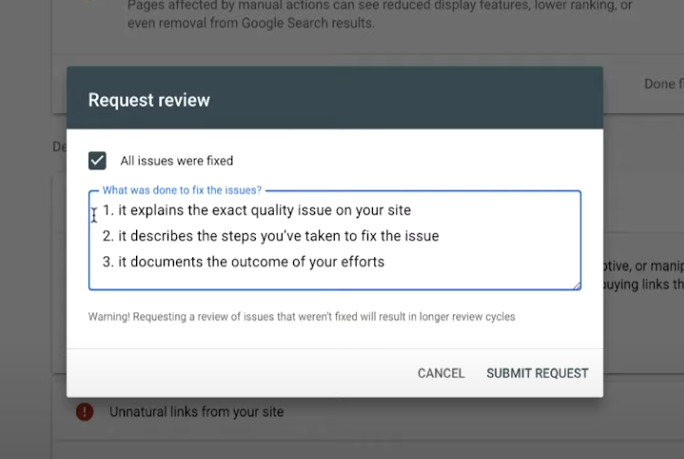
It’s important that you only send a request when all of the issues raised in your manual action penalty have been fixed. If you send a request and Google determines that you haven’t fixed all of the relevant issues, your request will be denied and subsequent review processes may take longer. Reconsideration reviews are normally completed in anywhere between a few days and a couple of weeks so you don’t want to give Google any reason to extend this period any further.
Once you’ve submitted your reconsideration request, you’ll receive a confirmation email telling you that your request has been received. Later, you’ll receive a further email to inform you when your review is complete – don’t resubmit requests while you have one outstanding.
Step #3: Put preventative measures in place to avoid future penalties
Overcoming Google penalties is hard work and, in most cases, you’re facing a significant drop in traffic until you get the penalty removed. It also gets harder to lift penalties if you’re a repeat offender so you don’t want to get caught out again in the future. More importantly, if you’re getting hit by Google penalties, you’re not making the most of the traffic you get (even before you get hit) or achieving your marketing goals.
So, once you’ve identified and fixed your penalty issues, put preventative measures in place to avoid any future penalties. For example, if you’ve been hit with an unnatural inbound link penalty, establish a system for regularly reviewing your link profile and disavowing any links that look irrelevant or unnatural.
Take this further by devising a workable link building strategy that earns quality links from relevant sites. If possible, do this before your reconsideration request is complete and your penalty is lifted. This way, when you start getting the full value from links again, you’ll get a bigger boost and put yourself in a good position to recover quickly and start building your search presence the right way.
Digital & Social Articles on Business 2 Community
(51)
